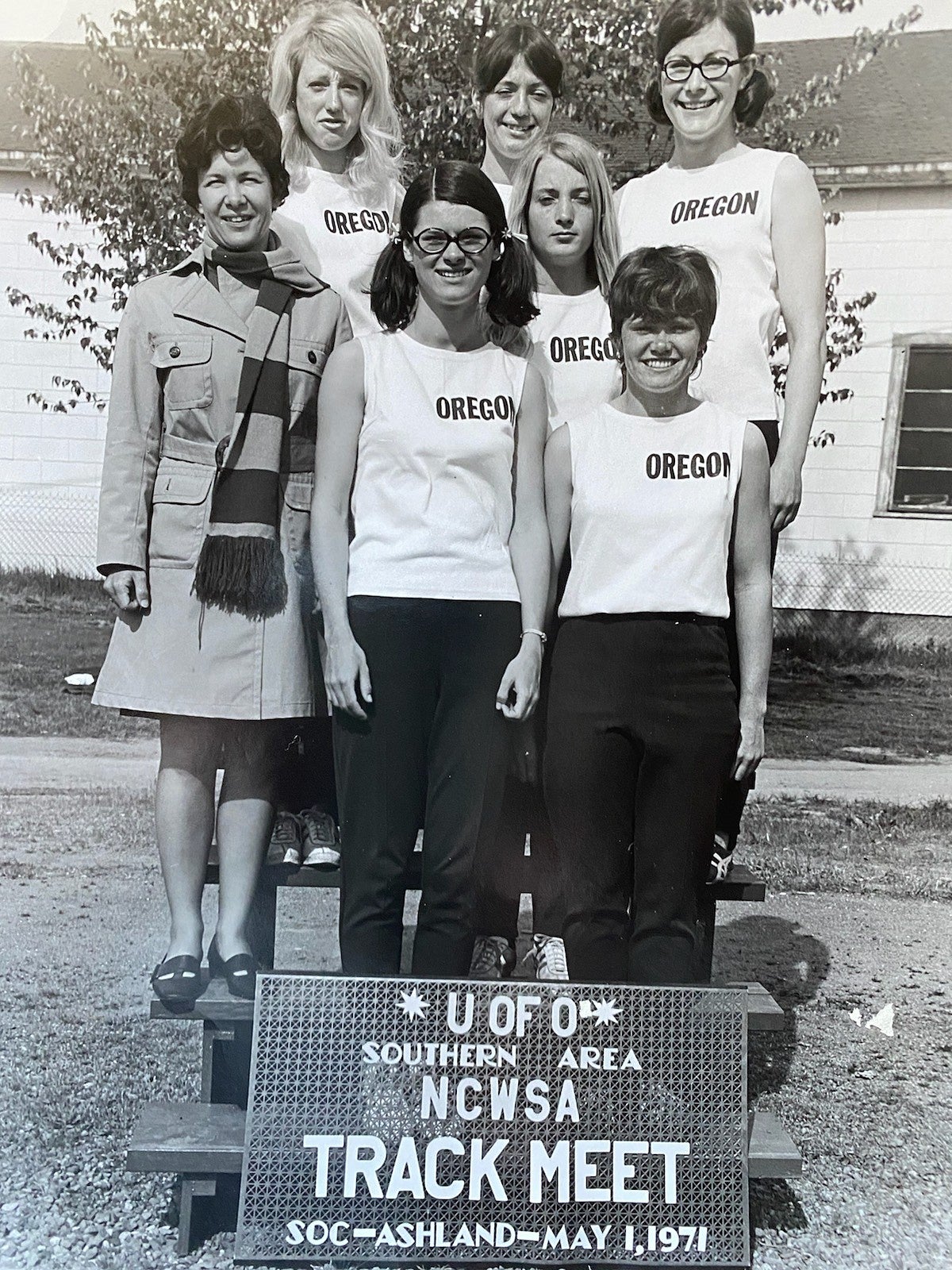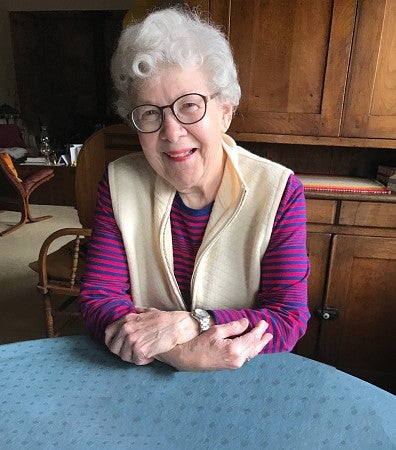Lois Youngen looks as if she walked straight out of a Norman Rockwell painting into the 1955 newspaper photo promoting a major league exhibition baseball game. The five-foot-three catcher—a self-described “runt”—embodies pugnacity with her fists doubled, biceps flexed, and cap pushed back from her forehead. Amped from a just-completed game, she is still wearing her chest protector, shin guards, and uniform, which featured what can only be described as a regulation miniskirt.
Yes, you read that right. Youngen, an 87-year-old Eugene resident and University of Oregon professor emerita of physical education who taught more than a dozen sports and activities, pursued research on human movement that focused on women, coached three intercollegiate sports, and helped lay the groundwork for the Student Recreation Center, was a professional baseball star.
Growing up in LeRoy, Ohio, Youngen played sandlot baseball with the boys, unaware of the existence of the All-American Girls Professional Baseball League until she was 16, when a cousin in Indiana invited her to see the Fort Wayne Daisies. “About the seventh inning, I proclaimed, ‘I can do that!’ and the next morning I had a tryout,” she says. The following year—1951—she received an invitation and $20 to go to spring training with the Daisies. She made the team, playing four seasons highlighted by catching a perfect game.
As much as she loved the sport, Youngen kept her eye on a different ball: a bachelor’s degree in physical education, which she pursued at Kent State University during the off-season. But after the 1954 season, owners shut down the women’s league, which had been created to fill the void in Major League Baseball caused by the absence of players serving in World War II.
Youngen wrapped up her bachelor’s in 1955 while playing one more year for the all-star women’s team that barnstormed the Midwest against men’s teams. Disappointed but undaunted by the loss of women’s professional baseball, she completed her master’s degree at Michigan State University, where she taught until joining the UO faculty in 1960.
By then, the fact that American women once were paid to play baseball professionally—and fiercely—was vanishing from public memory. “Nobody would ever have known we existed if it weren’t for Penny Marshall’s film A League of Their Own in 1992,” she says. “That made us all celebrities.”
While national awareness of the need to encourage highly skilled female athletes grew in the 1960s, especially in Oregon, Youngen was getting her Ducks in a row. On top of serving as the unpaid women’s tennis coach from 1964 to 1968, she volunteered to coach women’s basketball for the 1966 season.
She also spent part of her lunch hour teaching the UO’s lone coed physical activity class with men’s track-and-field coach Bill Bowerman. Until that point, PE activity courses were segregated by gender. Bowerman proposed a jogging course to be taken by men and women, together, but Dean Arthur Esslinger refused unless Bowerman could find a woman to teach it with him. Youngen stepped up.
“I said, ‘Let’s call it ‘Jog-Run’ because we will be working with 18- to 19-year-olds, so we ought to be able to get them running,’” Youngen recalls. Bowerman agreed.

A true competitor, Youngen enjoyed coaching, but it was a distant second to her identity as a physical education professor. She took great pride in working in the physical education teacher education program, producing outstanding future teachers for the state. “The research is clear: quality elementary and high school PE programs produce better classroom performance,” she points out. “All students should leave high school with lifetime sports skills and be physically fit.”
In 1971, she took a brief leave to finish her PhD in physical education at Ohio State University, returning to the UO for the run-up to passage of Title IX. This landmark legislation, led in large part by Oregon Representative Edith Green, BS ’40 (education), and enacted in 1972, prohibits sex discrimination in federally funded educational institutions.
Title IX transformed the athletic fortunes of women and girls. Universities were required to equalize athletic opportunities for college women and make all PE activities coeducational, virtually overnight. Youngen co-led the UO’s conversion to all-coed activities starting in the fall of 1972.

She went on to serve as the UO’s first director of Physical Activity and Recreation Services and was instrumental in securing funding for the recreation center before she retired in 1996.
Along the way, the knowledge Youngen gained from an investment club paid off well enough to support her philanthropic passions. Her first gift helped fund a Babe Ruth baseball complex in Eugene. Others honor her father and her UO mentors.
But her latest gift—a rotating scholarship that begins this fall for female tennis, track, and softball student-athletes entering their senior year—is dearest to Youngen’s heart.
“I felt it was the best way for me to show gratitude for my years of service to the UO,” she says. “My greatest satisfaction in life has been my teaching and the students.”
—By Melody Ward Leslie, BA ’79 (humanities), a staff writer for University Communications
—Photos courtesy of Lois Youngen


